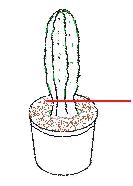TUTORIAL
PROPAGATION FROM CUTTING
INTRODUCTION
The reproduction by cuttings is one of the methods of asexual reproduction in plants. This is a technique by which, with proper precautions and in the presence of particular conditions, a part of a plant (taken from the mother plant) emits its own roots to give life to a new subject, through a regeneration process that reproduces exactly the plant it comes from. The plants raised from cuttings and from the same mother plant are called clones of the mother plant and retain the entire genetic heritage that, in the absence of sexual reproduction, undergoes no recombination. Consequently, the characteristics of the clones (in terms of coloration, shape, resistance to disease) will be identical to those of the parent plant. Exploiting the enormous regenerative properties of plants , this system also allows you to quickly and easily obtain adult plants: you can save diseased plants or rejuvenate old ones or malformed. The cuttings can be constituted from a fragment of leaf, branch, stem or root.
PREPARATION
Whatever part of the mother plant to perform the cutting, this will be taken using clean utensils , sterilized (possibly with alcohol) and very sharp. The cut should be immediately dusted with a fungicide and the cuttings should be left to rest in a shady position, warm and ventilated for at least a week. During this period, a callus will form and only then we can put the cuttings to root.
TYPES OF CUTTINGS
Stem cutting
Usual when the lower part of the plant, in the area closest to the neck, is attacked by rot or parasites that, propagating, may compromise the entire plant. The cut should be performed preferably at the point of the healthy plant closest to the ground; the basal part of the cuttings must be contoured in the shape of an inverted cone, taking care not to affect the central beams. In the case of cuttings of Euphorbia, it is good to immerse the wound in hot water for a few minutes, to avoid that the cutting to form a clot that would prevent the subsequent rooting.
Recommanded for: [Cereus] [Euphorbia] [Crassula] [Mammillaria]

Branch cutting
The branch cuttings, very common in some species of succulents, must be performed a few millimeters below a node. Care should be taken to remove any lower leaves and shorten the upper ones. The healing of this cuttings will be faster, since the cutting is smaller than that of a stem. The narrow elements, like the blades of Opuntia, should be cut at an angle.
Recommanded for: [Opuntia] [Crassula] [Sedum] [Rebutia] [Sulcorebutia]

Leaf cutting
Quite simply, this type of cutting is practiced by pulling a leaf with a sharp instrument, leaving it to dry for a few hours and then resting it on the slightly damp soil.
Recommanded for: [Gasteria] [Hawortia] [Echeveria] [Pachyphytum] [Sedum] [Kalanchoe] [Adromischus]

Root cutting
There are not many succulent reproduced in this way. The procedure involves the removal of portions of the main roots to bury and cover with a few inches of soil.
Recommanded for: [Leuchtenbergia]

PLANTING
For the selection of the soil to bury our cuttings, the same considerations made for the mother plant apply (see tutorial sowing), making sure to abound with slightly sandy component of the mixture. In the case of cutting sowing the sterilization of the soil is very important, since the cutting constitutes a preferential channel of engraftment of mold and rot. The cuttings should be put to a depth of no more than 2-3 cm.
ENVIRONMENTAL CONDITIONS
The best period to do cuttings corresponds to the growing season of plants: that is, in most cases, the spring and summer seasons. The cuttings should be put to root at a temperature of 20-25°C and in a moist and bright place. The ambient humidity must be present (to prevent cutting wither), but not excessive, to prevent the development of rots. In the first few days you can use rooting hormone dissolved in the water of wetting: they stimulate the emission of roots and speed up the process of engraftment. We realize that the cuttings took root when we notice that its position in the soil is consolidated, a symptom of the issue of their own roots. At this point, the environment can become moderately more aerated and subsequently the plant, now self-sufficient, can be repotted or placed together with the other.






